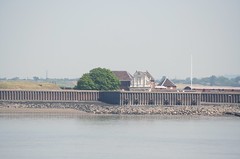Saturday, June 24, 2006
Thursday, June 22, 2006
Tuesday, June 20, 2006
Category : Photo flickr 20:06 project

-- from izreloaded - (?)
..for the group project time and date mine is here
Category : Gadgets CCD security
Dave posted this article about a new paper by georgia institute of technology flickr group discussion - puts a whole new meaning to someone blinking when you take their picture
Sunday, June 18, 2006
Category : Photo flickr ben ezra synagogue cairo

-- from Prora - (?)
Re-Engineering the Ark
From Exodus to Indiana Jones, the Ark of the Covenant has been described as possessing awesome destructive powers – but how did it work? Michael Blackburn and Mark Bennett believe they have found the answer, and that it reveals a mastery of the forces of electricity not normally associated with Biblical times and technologies.
In a secular age such as ours, it’s not unlikely that more people will be familiar with the story of the Ark of the Covenant from Steven Spielberg’s blockbuster (and first Indiana Jones film) Raiders of the Lost Ark than from its pivotal appearance in the Old Testament, a book held as the actual word of God by two major religions.
In the movie, of course, Hitler’s Nazis seek the ancient artefact in order to harness its mysterious power as a devastating weapon against their enemies (and end up getting fried by it in the process).
Surprisingly, though, Hollywood got it more or less right: the Ark indeed held the lethal and devastating power of God, which was to be used as a weapon by those who possessed it.
But beyond the Bible itself there are no clues, maps or traces to follow, no ancient remains or fragments to find: the Ark’s very existence is dependant purely upon one of the most influential – and yet most heavily edited and historically dubious – books ever written. All we have are the biblical descriptions, and the Ark remains no more tangible than many other biblical stories. It has until now been a matter of pure belief, not fact.
But if we were to take the information provided in the Bible, could we use it to decode what the Ark actually was? Could one be built, even on a small scale, using substances and technologies available during the Biblical period?
The Ark of the Covenant was a machine designed, created and used for a specific purpose, and the technology involved is easily understood by anyone who has ever received a shock from a supermarket trolley or had the misfortune to wear nylon. Today, the concepts behind the Ark are readily understood, but at the time of its creation it must have been beyond the comprehension of most people, an awe-inspiring artefact. As Arthur C Clark famously wrote: “Any sufficiently advanced technology is indistinguishable from magic”. To those who saw the Ark, it really must have seemed as if the power of God had been stolen from the sacred mountaintop and now resided within the golden Temple, held captive to the will of men. Which is, in effect, precisely what happened, but not quite as we have been led to believe.
LIGHTNING IN A JAR
Over 250 years ago, a Dutch scientist called Pieter Van Musschenbroek (1692-1761) sent a report to the Paris Academy of Sciences outlining his experiments with electricity, and created a sensation. The year was 1747.
His invention, destined to be immortalised as the Leyden Jar, named after Van Musschenbroek’s home town and university, was a very simple device that accumulated and stored a large amount of electricity which, when discharged, could deliver a very powerful punch. As the inventor himself wrote: “My whole body was shaken as though by a thunderbolt”.
In terms of 18th-century science Van Musschenbroek’s seemingly miraculous invention soon excited the curiosity of his fellow scientists. Benjamin Franklin called it “Musschenbroek’s wonderful bottle”, and went on to carry out a series of often painful tests to determine exactly how one could produce such a powerful “electrical commotion” from little more than a glass bottle filled with water.
Franklin thought the Leyden Jar would be a good way to kill turkeys, and carried out trials. Using one jar the size of a pint glass, he knocked himself unconscious for several hours. His most famous experiment used a kite to capture lightning in a Leyden Jar with a silk thread and key. Some recent scholars doubt that Franklin actually performed this test – the next two people who attempted it were killed in the effort.
Prior to the discovery of the properties of the Leyden Jar, the only means of producing electricity had been by friction machines – glass globes rotated against leather or silk pads, which generated small static charges. The Leyden Jar, although dependant upon friction machines for charging, represented a major advance in the understanding and development of electricity that would not be superseded until Allasandro Volta created the Voltaic pile (which produced an electrochemical reaction) in 1800.
A description taken from a book published in 1899 describes the Leyden Jar (pictured above) thus:
It consists of a glass jar, coated outside and inside with tinfoil to within 2 or 3 cm of the top. It may therefore be regarded as a condenser (capacitor) consisting of two parallel plates (positive and negative) separated by a glass dielectric (insulator). The jar is provided with a wooden lid, through the centre of which passes a brass rod, terminating in a brass knob; a short length of metal chain is attached to the lower end, and of sufficient length to touch the tinfoil lining. The tinfoil serves as the insulated conductor, which may be conveniently charged through the knob; the jar is either placed on a table or held in the hand, so that the outer coating is consequently earth-connected.
From these descriptions it is certainly possible, even with only a rudimentary knowledge of electricity, to understand the basic principles involved and to construct a working version. What the description doesn’t tell us, though, is how large the volume of the jar is in relation to the charge. To give an example, a 500–1,000gm (1.1–2.2lb) jar, such as an average coffee or storage jar, would be capable of producing a charge in excess of the 220-volt domestic supply.
So, while it would be easy enough for Blue Peter to instruct the nation’s children in how to build a Leyden Jar out of common household items, it wouldn’t be advisable, as they are potentially highly dangerous devices.
Today, the Leyden Jar may be regarded as a little piece of crude but important technical history, but it has been in constant use in the 250-odd years since its invention. It survives to this day in the more advanced form of the capacitor, which works upon exactly the same principles, although in a more highly refined manner. It remains one of the key components in countless modern electrical devices and systems and is produced in vast numbers – over 200 thousand million units per year.
more via david pescovitz
Category : Shopping celeb helena christensen

-- from :Nikola - (?)
..the london telegraph magazine 'stella' supermodel opened a boutique 'butik' in nyc two months ago photoed by grant delin and partnered with leif sigersen writes susan dominus [sfgate article]
Category : Movies tv sci fi
Watched the serie of star trek 8472 which I never got to take in memorably which was the devil in carnet [ring any bells] for us humans - even the borg [we will asimulate - resistance is futile] that's why enterprise kicked the bucket cause to evolve you have to have hope - and fuckin good luck - but the bbc is doing a brand new sci fi drama which I found in the times but the point of this is that the trek is fourty light years old in three months





